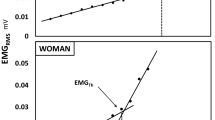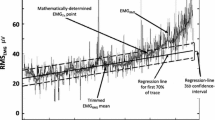Abstract
Background
Children have been hypothesized to utilize higher-threshold (type-II) motor units (MUs) to a lesser extent than adults. Two recent studies, using a cycling-based EMG-threshold (EMGTh) protocol, supported the hypothesis, showing children’s EMGTh intensities to be higher than adults’. Conclusions, however, were hampered by children’s low EMGTh detection rates. Insufficiently high contractile forces at exhaustion were postulated as the reason for non-detection, predominantly in children. An intermittent isometric contraction test (IICT) protocol facilitates higher contractile forces prior to exhaustion and was shown effective in EMGTh testing of adults.
Purpose
Determine whether an IICT protocol would enhance EMGTh detection in children, and consequently increase the magnitude of the previously observed child–adult EMGTh differences.
Methods
18 boys and 21 men completed one-repetition-maximum (1RM) isometric knee-extension test. The IICT protocol followed, commencing at 25%1RM and comprising five isometric contractions per load, incremented by ~ 3%1RM to exhaustion. Vastus lateralis surface EMG was recorded and EMGTh, expressed as %1RM, was defined as the onset of the EMG-response’s steeper segment.
Results
EMGTh was detected in 88.9% of boys and 95.2% of men, and occurred at higher relative intensities in boys (56.4 ± 9.2%1RM) than in men (46.0 ± 6.8%1RM). This 10.4% difference was 57% greater than the corresponding, previously reported cycling-based age-related difference.
Conclusions
With the boys’ detection rate nearly on par with the men’s, the IICT protocol appears to overcome much of the intensity limitation of cycling-based protocols and provide a more sensitive EMGTh detection tool, thus extending the previously observed boys‒men difference. This difference adds supports to the notion of children’s more limited type-II MU recruitment capacity.



Similar content being viewed by others
Abbreviations
- EMG:
-
Electromyography
- EMGTh :
-
Electromyographic threshold
- EMGRMS :
-
Root mean square of each contraction’s EMG signal
- EMGRMS5:
-
Average of EMGRMS values for each load
- IICT:
-
Intermittent isometric contraction test
- LBM:
-
Lean body mass
- LSS:
-
Least sum of squares
- MU:
-
Motor units
- MVC:
-
Maximal volitional contraction
- RM:
-
Repetition maximum
- RMS:
-
Root mean square
References
Armatas V, Bassa E, Patikas D, Kitsas I, Zangelidis G, Kotzamanidis C (2010) Neuromuscular differences between men and prepubescent boys during a peak isometric knee extension intermittent fatigue test. Pediatr Exerc Sci 22:205–217
Asai H, Aoki J (1996) Force development of dynamic and static contractions in children and adults. Int J Sports Med 17:170–174
Asmussen E, Heeboll-Nielsen K (1955) A dimensional analysis of physical performance and growth in boys. J Appl Physiol 7:593–603
Camic CL, Housh TJ, Johnson GO, Hendrix CR, Zuniga JM, Mielke M, Schmidt RJ (2010) An EMG frequency-based test for estimating the neuromuscular fatigue threshold during cycle ergometry. Eur J Appl Physiol 108:337–345
Camic CL, Housh TJ, Hendrix CR, Zuniga JM, Bergstrom HC, Schmidt RJ, Johnson GO (2011) The influence of the muscle fiber pennation angle and innervation zone on the identification of neuromuscular fatigue during cycle ergometry. J Electromyogr Kinesiol 21:33–40
Candotti CT, Loss JF, Melo Mde O, La Torre M, Pasini M, Dutra LA, de Oliveira JL, de Oliveira LP (2008) Comparing the lactate and EMG thresholds of recreational cyclists during incremental pedaling exercise. Can J Physiol Pharmacol 86:272–278
Chwalbinska-Moneta J, Kaciuba-Uscilko H, Krysztofiak H, Ziemba A, Krzeminski K, Kruk B, Nazar K (1998) Relationship between EMG blood lactate, and plasma catecholamine thresholds during graded exercise in men. J Physiol Pharmacol 49:433–441
De Ruiter CJ, Hamacher P, Wolfs BG (2016) A short submaximal test to determine the fatigue threshold of knee extensors in young men. Med Sci Sports Exerc 48:913–919
De Ste Croix MBA, Armstrong N, Welsman JR (1999) Concentric isokinetic leg strength in pre-teen, teenage and adult males and females. Biol Sport 16:75–88
Dotan R, Mitchell C, Cohen R, Klentrou P, Gabriel D, Falk B (2012) Child-adult differences in muscle activation—a review. Pediatr Exerc Sci 24:2–21
Falk B, Dotan R (2006) Child-adult differences in the recovery from high-intensity exercise. Exerc Sport Sci Rev 34:107–112
Falk B, Usselman C, Dotan R, Brunton L, Klentrou P, Shaw J, Gabriel D (2009) Child-adult differences in muscle strength and activation pattern during isometric elbow flexion and extension. Appl Physiol Nutr Metab 34:609–615
Fawkner SG, Armstrong N (2004) Longitudinal changes in the kinetic response to heavy-intensity exercise in children. J Appl Physiol 97:460–466
Godin G, Shephard RJ (1985) A simple method to assess exercise behavior in the community. Can J Appl Sport Sci 10:141–146
Greig C, Sargeant AJ, Vollestad NK (1985) Muscle force and fibre recruitment during dynamic exercise in man. J Physiol Lond 371:176P
Hatzikotoulas K, Patikas D, Ratel S, Bassa E, Kotzamanidis C (2014) Central and peripheral fatigability in boys and men during maximal contraction. Med Sci Sports Exerc 46:1326–1333
Hebestreit H, Mimura K, Bar-Or O (1993) Recovery of muscle power after high-intensity short-term exercise: comparing boys and men. J Appl Physiol 74:2875–2880
Henneman E, Somjen G, Carpenter DO (1965) Functional Significance of Cell Size in Spinal Motoneurons. J Neurophysiol 28:560–580
Hug F, Laplaud D, Savin B, Grelot L (2003) Occurrence of electromyographic and ventilatory thresholds in professional road cyclists. Eur J Appl Physiol 90:643–646
Hug F, Decherchi P, Marqueste T, Jammes Y (2004) EMG versus oxygen uptake during cycling exercise in trained and untrained subjects. J Electromyogr Kinesiol 14:187–195
Hug F, Laplaud D, Lucia A, Grelot L (2006a) A comparison of visual and mathematical detection of the electromyographic threshold during incremental pedaling exercise: a pilot study. J Strength Cond Res 20:704–708
Hug F, Laplaud D, Lucia A, Grelot L (2006b) EMG threshold determination in eight lower limb muscles during cycling exercise: a pilot study. Int J Sports Med 27:456–462
Jurimae J, von Duvillard SP, Maestu J, Cicchella A, Purge P, Ruosi S, Jurimae T, Hamra J (2007) Aerobic-anaerobic transition intensity measured via EMG signals in athletes with different physical activity patterns. Eur J Appl Physiol 101:341–346
Klentrou N, Nishio M-L, Plyley M (2006) Ventilatory breakpoints in boys and men. Pediatr Exerc Sci 18:216–225
Long D, Dotan R, Pitt B, McKinlay B, O'Brien TD, Tokuno C, Falk B (2017) The Electromyographic Threshold in Girls and Women. Pediatr Exerc Sci 29:84–93
Lucia A, Sanchez O, Carvajal A, Chicharro JL (1999) Analysis of the aerobic-anaerobic transition in elite cyclists during incremental exercise with the use of electromyography. Br J Sports Med 33:178–185
Maestu J, Cicchella A, Purge P, Ruosi S, Jurimae J, Jurimae T (2006) Electromyographic and neuromuscular fatigue thresholds as concepts of fatigue. Journal of strength and conditioning research / National Strength & Conditioning Association 20:824–828
Malina RM (1969) Quantification of fat, muscle and bone in man. Clin Orthop Relat Res 65:9–38
Miyashita M, Kanehisa H (1980) Correlation between efficiency in cycling and maximal power of human extensor muscles. J Sports Med Phys Fitness 20:365–370
Moritani T, deVries HA (1978) Reexamination of the relationship between the surface integrated electromyogram (IEMG) and force of isometric contraction. Am J Phys Med 57:263–277
Moritani T, Takaishi T, Matsumoto T (1993) Determination of maximal power output at neuromuscular fatigue threshold. J Appl Physiol (1985) 74:1729–1734
O'Brien TD, Reeves ND, Baltzopoulos V, Jones DA, Maganaris CN (2010) In vivo measurements of muscle specific tension in adults and children. Exp Physiol 95:202–210
Pitt B, Dotan R, Millar J, Long D, Tokuno C, O'Brien T, Falk B (2015) The electromyographic threshold in boys and men. Eur J Appl Physiol 115:1273–1281
Ratel S, Kluka V, Vicencio SG, Jegu AG, Cardenoux C, Morio C, Coudeyre E, Martin V (2015) Insights into the mechanisms of neuromuscular fatigue in boys and men. Med Sci Sports Exerc 47:2319–2328
Riddell MC, Jamnik VK, Iscoe KE, Timmons BW, Gledhill N (2008) Fat oxidation rate and the exercise intensity that elicits maximal fat oxidation decreases with pubertal status in young male subjects. J Appl Physiol 105:742–748
Sargeant AJ, Hoinville E, Young A (1981) Maximum leg force and power output during short-term dynamic exercise. J Appl Physiol Respir Environ Exerc Physiol 51:1175–1182
Simon G, Berg A, Simon-Alt A, Keul J (1981) Determination of the anaerobic threshold depending on age and performance potential. Dtsch Z Sportsmed 32:7–14
Tanaka H, Shindo M (1985) Running velocity at blood lactate threshold of boys aged 6–15 years compared with untrained and trained young males. Int J Sports Med 6:90–94
Tanner JM (1962) Growth at Adolescence. Blackwell Scientific Publications, Oxford
Taylor AD, Bronks R (1996) Effect of acute normobaric hypoxia on quadriceps integrated electromyogram and blood metabolites during incremental exercise to exhaustion. Eur J Appl Physiol Occup Physiol 73:121–129
Vollestad NK, Blom PC (1985) Effect of varying exercise intensity on glycogen depletion in human muscle fibres. Acta Physiol Scand 125:395–405
Vollestad NK, Vaage O, Hermansen L (1984) Muscle glycogen depletion patterns in type I and subgroups of type II fibres during prolonged severe exercise in man. Acta Physiol Scand 122:433–441
Yoder NC (2011) “Peak Finder,” Matlab program. http://www.mathworks.com/matlabcentral/fileexchange/25500-peakfinder
Zafeiridis A, Dalamitros A, Dipla K, Manou V, Galanis N, Kellis S (2005) Recovery during high-intensity intermittent anaerobic exercise in boys, teens, and men. Med Sci Sports Exerc 37:505–512
Acknowledgements
The authors wish to thank all participants for their hard work and dedication and to the parents or guardians for bringing the boys and making it all possible.
Funding
The study was funded by a Brock University internal grant.
Author information
Authors and Affiliations
Contributions
SW, RD and BF conceived and designed research. SW, NJ, RD and JM conducted the experiments. RD designed and built the custom-made ergometer. SW and RD analyzed the data. SW, RD and BF wrote the manuscript. DG and CT contributed to the design of the experiments and the analysis approach. All the authors read and approved the manuscript.
Corresponding author
Ethics declarations
Conflict of interest
The authors have no competing interests to declare.
Additional information
Communicated by Toshio Moritani.
Publisher's Note
Springer Nature remains neutral with regard to jurisdictional claims in published maps and institutional affiliations.
Rights and permissions
About this article
Cite this article
Woods, S., Dotan, R., Jenicek, N. et al. Isometric-based test improves EMG-threshold determination in boys vs. men. Eur J Appl Physiol 119, 1971–1979 (2019). https://doi.org/10.1007/s00421-019-04185-8
Received:
Accepted:
Published:
Issue Date:
DOI: https://doi.org/10.1007/s00421-019-04185-8




